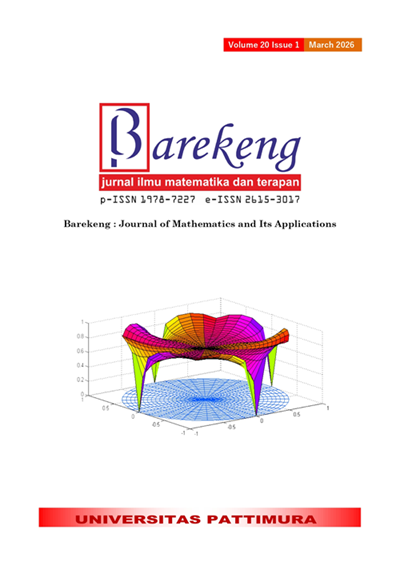BAYESIAN ESTIMATION OF THE SCALE PARAMETER OF THE WEIBULL DISTRIBUTION USING THE LINEX AND ITS APPLICATION TO STROKE PATIENT DATA
Abstract
Survival analysis is used to study the timing of an event, such as recovery or death, in the context of medical data. One of the diseases that many people suffer from is stroke. Based on the survey results, the number of stroke sufferers in Indonesia reached 8.3% of 1000 people in Indonesia continues to increase every year, especially among the elderly. The research conducted aims to model the estimation of the type III censored Weibull distribution parameters with the Bayesian Linear Exponential Loss Function (LINEX) method. This study uses secondary data on stroke patients in the period January-November 2024 with a sample of 62 patients at the Haji Surabaya Regional General Hospital. Weibull distribution model with Bayesian approach using Linear Exponential Loss Function (LINEX) was applied to estimate the distribution parameters and survival function. The estimation results show that the parameter α is 6.32342 with an average hospitalization time of 5.9151646 days. MSE value is 0.000270555, which indicates that the estimation model is more accurate in predicting data for the length of hospitalization for stroke patients at the Haji Surabaya Regional General Hospital. The probability value of the survival function of stroke patients who have been hospitalized on the 5th day shows a probability of 82.4% so that no further hospitalization is needed, which indicates that the patient's health condition is improving. In addition, the hazard function analysis shows that the longer a patient is hospitalized, the greater the risk of the patient not recovering.
Downloads
References
D. Mitra, D. Kundu, and N. Balakrishnan, “LIKELIHOOD ANALYSIS AND STOCHASTIC EM ALGORITHM FOR LEFT TRUNCATED RIGHT CENSORED DATA AND ASSOCIATED MODEL SELECTION FROM THE LEHMANN FAMILY OF LIFE DISTRIBUTIONS,” Japanese Journal of Statistics and Data Science, vol. 4, no. 2, pp. 1019–1048, 2021, doi: https://doi.org/10.1007/s42081-021-00115-1.
W. B. Nelson, “STATISTICAL METHODS FOR RELIABILITY DATA, SECOND EDITION,” Technometrics, vol. 63, no. 3, pp. 437–440, 2021, doi: https://doi.org/10.1080/00401706.2021.1945328.
P. V. Shishkin et al., “DEVELOPMENT OF A MATHEMATICAL MODEL OF OPERATION RELIABILITY OF MINE HOISTING PLANTS,” Mathematics, vol. 12, no. 12, pp. 1–24, 2024, doi: https://doi.org/10.3390/math12121843.
D. Collet, MODELLING SURVIVAL DATA IN MEDICAL RESEARCH, 3rd ed. CRC Press, 2015.doi: https://doi.org/10.1201/b18041
J. Le-Rademacher and X. Wang, “TIME-TO-EVENT DATA: AN OVERVIEW AND ANALYSIS CONSIDERATIONS,” Journal of Thoracic Oncology, vol. 16, no. 7, pp. 1067–1074, Jul. 2021, doi: https://doi.org/10.1016/j.jtho.2021.04.004
E. Mahmoudi and M. Shiran, “EXPONENTIATED WEIBULL-GEOMETRIC DISTRIBUTION AND ITS APPLICATIONS,” arXiv preprint arXiv:1206.4008, 2012.
H. Wang, B. Abba, and J. Pan, “CLASSICAL AND BAYESIAN ESTIMATIONS OF IMPROVED WEIBULL–WEIBULL DISTRIBUTION FOR COMPLETE AND CENSORED FAILURE TIMES DATA,” Appl Stoch Models Bus Ind, vol. 38, no. 6, pp. 997–1018, Nov. 2022, doi: https://doi.org/10.1002/asmb.2698.
E. M. Eldemery, A. M. Abd-Elfattah, K. M. Mahfouz, and M. M. El Genidy, “BAYESIAN AND E-BAYESIAN ESTIMATION FOR THE GENERALIZED RAYLEIGH DISTRIBUTION UNDER DIFFERENT FORMS OF LOSS FUNCTIONS WITH REAL DATA APPLICATION,” Journal of Mathematics, vol. 2023, pp. 1–25, Aug. 2023, doi: https://doi.org/10.1155/2023/5454851.
P. A. Raharja, M. F. Sidiq, and D. C. Fransisca, “COMPARATIVE ANALYSIS OF MULTINOMIAL NAÏVE BAYES AND LOGISTIC REGRESSION MODELS FOR PREDICTION OF SMS SPAM,” Jurnal Media Informatika Budidarma, vol. 6, no. 3, p. 1290, 2022, doi: https://doi.org/10.30865/mib.v6i3.4019.
M. S. A. Muiftah and S. K. Ashour, “ESTIMATION OF THE PARAMETERS OF TYPE-II DISCRETE WEIBULL DISTRIBUTION UNDER TYPE-I CENSORING,” Int J Stat Probab, vol. 10, no. 5, p. 1, 2021, doi: https://doi.org/10.5539/ijsp.v10n5p1.
A. Kurniawan, R. K. Rahmanta, and E. Tjahjono, “PARAMETER ESTIMATION OF WEIBULL DISTRIBUTION ON TYPE III CENSORED SURVIVAL DATA BY MAXIMUM LIKELIHOOD ESTIMATOR METHOD: CASE STUDY OF LUNG CANCER PATIENT DATA AT DR. KARIADI HOSPITAL SEMARANG,” Communications in Mathematical Biology and Neuroscience, vol. 2023, pp. 1–9, 2023, doi: https://doi.org/10.28919/cmbn/7937.
H. R. Abdullah, “COMPARISON OF THE BAYESIAN ESTIMATIONS UNDER DIFFERENT LOSS FUNCTION AND MAXIMUM LIKELIHOOD ESTIMATION FOR RAYLEIGH DISTRIBUTION,” SSRN Electronic Journal, no. January 2016, 2017, doi: https://doi.org/10.2139/ssrn.2869057.
Afriani, A. Kurniawan, and E. Ana, “BAYES ESTIMATOR PARAMETERS EXPONENTIAL DISTRIBUTION OF TYPE I SENSOR DATA USING LINEAR EXPONENTIAL LOSS FUNCTION METHOD BASED ON PRIOR JEFFREY,” International Journal of Statistical Distributions and Applications, vol. 9, no. 2, pp. 62–67, 2023, doi: https://doi.org/10.11648/j.ijsd.20230902.12.
A. Kurniawan, J. T. Victory, and T. Saifudin, “BAYES ESTIMATION OF A TWO-PARAMETER EXPONENTIAL DISTRIBUTION AND ITS IMPLEMENTATION,” Telkomnika (Telecommunication Computing Electronics and Control), vol. 22, no. 6, pp. 1443–1449, 2024, doi: https://doi.org/10.12928/telkomnika.v22i6.26015.
M. M. Abdelwahab, A. Ben Ghorbal, A. S. Hassan, M. Elgarhy, E. M. Almetwally, and A. F. Hashem, “CLASSICAL AND BAYESIAN INFERENCE FOR THE KAVYA–MANOHARAN GENERALIZED EXPONENTIAL DISTRIBUTION UNDER GENERALIZED PROGRESSIVELY HYBRID CENSORED DATA,” Symmetry (Basel), vol. 15, no. 6, Jun. 2023, doi: https://doi.org/10.3390/sym15061193.
W. H. Organization, “WORLD HEALTH STATISTICS 2022 : MONITORING HEALTH FOR THE SDGS. WHO.”
F. F. Chrisna and S. Martini, “HUBUNGAN ANTARA SINDROMA METABOLIK DENGAN KEJADIAN STROKE,” Jurnal Berkala Epidemiologi, vol. 4, no. 1, pp. 25–36, 2016, doi: https://doi.org/10.20473/jbe.v4i1.2016.25-36.
V. L. Feigin et al., “GLOBAL, REGIONAL, AND NATIONAL BURDEN OF STROKE AND ITS RISK FACTORS, 1990-2019: A SYSTEMATIC ANALYSIS FOR THE GLOBAL BURDEN OF DISEASE STUDY 2019,” Lancet Neurol, vol. 20, no. 10, pp. 1–26, 2021, doi: https://doi.org/10.1016/S1474-4422(21)00252-0.
S. I. Lomo, S. Sugiyarto, and E. Darmawan, “A SURVIVAL ANALYSIS WITH COX REGRESSION INTERACTION MODEL OF TYPE II DIABETES MELLITUS IN INDONESIAN,” Jurnal Profesi Medika : Jurnal Kedokteran dan Kesehatan, vol. 15, no. 1, pp. 81–90, 2021, doi: https://doi.org/10.33533/jpm.v15i1.2942.
M. N. Faladiba and A. Ahdika, “BAYES ESTIMATION OF EXPONENTIALLY DISTRIBUTED SURVIVAL DATA UNDER SYMMETRIC AND ASYMMETRIC LOSS FUNCTIONS,” BAREKENG: Jurnal Ilmu Matematika dan Terapan, vol. 18, no. 2, pp. 0973–0986, 2024, doi: https://doi.org/10.30598/barekengvol18iss2pp0973-0986
N. Khatun and M. A. Matin, “A STUDY ON LINEX LOSS FUNCTION WITH DIFFERENT ESTIMATING METHODS,” Open J Stat, vol. 10, no. 01, pp. 52–63, 2020, doi: https://doi.org/10.4236/ojs.2020.101004.
Copyright (c) 2025 Tentri Ryan Rahmanita, Ardi Kurniawan, Elly Ana, Sediono Sediono, Dita Amelia

This work is licensed under a Creative Commons Attribution-ShareAlike 4.0 International License.
Authors who publish with this Journal agree to the following terms:
- Author retain copyright and grant the journal right of first publication with the work simultaneously licensed under a creative commons attribution license that allow others to share the work within an acknowledgement of the work’s authorship and initial publication of this journal.
- Authors are able to enter into separate, additional contractual arrangement for the non-exclusive distribution of the journal’s published version of the work (e.g. acknowledgement of its initial publication in this journal).
- Authors are permitted and encouraged to post their work online (e.g. in institutional repositories or on their websites) prior to and during the submission process, as it can lead to productive exchanges, as well as earlier and greater citation of published works.






1.gif)



